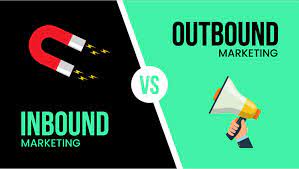What are the advantages and disadvantages of Inbound Marketing versus Outbound Marketing? This question is crucial to putting together an effective marketing campaign. Both types of campaigns have their own strengths, but knowing which one is best for your objective can make a profound difference to your bottom line.
In this article, we will clearly identify the main components that distinguish Inbound Marketing from Outbound, discuss how each strategy can contribute to your business and present practical ideas on how to get started with both approaches. Come on!
Introduction to the basic concepts of Inbound and Outbound Marketing
Inbound Marketing and Outbound Marketing are two key marketing strategies that most businesses use to reach a wider audience. With technology increasingly evolving, inbound and outbound have become important ways to bring brands, products and services to all demographics. Inbound focuses on engaging the potential customer with relevant, targeted and interesting content, such as blogs, articles and videos. Outbound focuses on traditional advertising, such as TV commercials, newspaper or radio advertising and billboards. Both have their advantages; however, designing a successful marketing plan involves using both types of strategy to achieve the best results.
The main differences between Inbound and Outbound Marketing
Customer relationship management (CRM) has changed dramatically in recent years, and these differences between Inbound and Outbound marketing have contributed to this. Outbound marketing relies on traditional advertising, such as radio or TV commercials, newsletters or print ads. These options can help you reach your target audience quickly, but it is limited by geographic reach and is not as personalised as Inbound Marketing. Inbound Marketing uses targeted content that engages potential customers when they are looking for solutions to their problems. Instead of interrupting them with intrusive messages, it offers educational and relevant content to help them make conscious buying decisions. This technique not only creates an important foundation for future customer relationships, but also generates optimal conversions to ensure your budget is profitable and compelling for your brand.
Advantages of Inbound Marketing
Inbound Marketing is the perfect marketing strategy for businesses in the digital age. This technique is based on attracting target audiences using valuable and relevant content, resulting in increased web traffic and better quality sales opportunities. The main benefits of Inbound Marketing include a significant increase in customer engagement, improved online visibility, increased organic reach, search engine optimisation and higher advertising returns. If implemented correctly, Inbound Marketing can be an invaluable resource for brands looking to expand their revenue.
Disadvantages of Outbound Marketing
Outbound Marketing has often been seen as a great technique for generating leads. However, many practitioners have recently reviewed its effectiveness and are discovering some of its disadvantages. For example, a major disadvantage is the cost associated with content production; creating television, radio or other advertising media can be relatively expensive compared to other forms of marketing. In addition, the "interrupt" method used in Outbound Marketing no longer receives the response it once did. Saturated markets mean that ads and promotions lose their impact, which means that there is less interaction between consumers and brands. Finally, a limited return on investment (ROI) forces some companies to devote more and more budget to Outbound Marketing without significant long-term results.
How to combine Inbound and Outbound Marketing
Inbound Marketing and Outbound Marketing have different objectives, however they can be effectively combined to maximise results. The goal of Inbound Marketing is to generate organic traffic interested in your content, get qualified leads and convert them into customers. The goal of Outbound Marketing is to expand your reach to a wider audience, reaching potential customers beyond what you could find via Inbound. If both methods are used properly, the result is a hybrid marketing between them that personalises the interaction with users by learning from the information they present and builds better relationships between the brand and its consumers, obtaining great benefits and increasing sales.
Implementation strategies for successful results
When implementing strategies for successful outcomes, there are some important things to keep in mind. First, there must be a strong commitment from all parties involved in the process. This involves not only management, but also the employees who work directly on the implementation. In addition, it is important to identify and document key processes, define clear responsibilities and communicate the strategic plan to all levels of staff. Finally, once implemented, it is vital to closely monitor progress and make adjustments accordingly to maximise its successful outcomes.
In conclusion, understanding the difference between inbound and outbound marketing gives us a great advantage to improve our marketing campaigns. A successful combination of Inbound and Outbound Marketing strategies can ensure optimal results in terms of improved engagement and new customer acquisition. By strategically formulating a plan based on the basic concepts discussed above and adopting various ways of delivering meaningful, impactful and innovative experiences to their customers, any business can achieve long-term benefits of the kind they have always longed for. In short, unleashing the true power of marketing requires ingenuity and motivation to maximise advertising potential both on and off social media.

